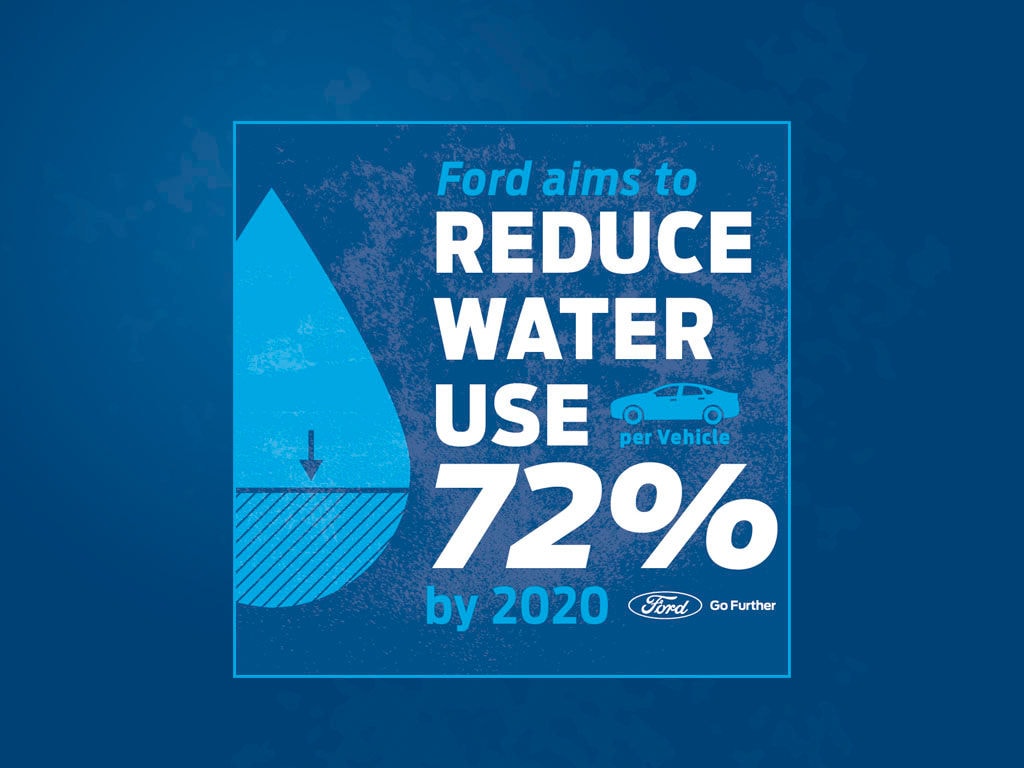

By Noah Patterson
In an effort yet to be match by any other North American company, Ford is continuing its initiative to reduce water use in its manufacturing process by nearly 75%. Ford’s goal is to use zero potable — aka drinkable — water in the production of its vehicles.
This goal is the continuation of an effort started in 2000. Between 2000 and 2015, Ford reduced its water use by 61%. Between 2015 and 2020, Ford anticipates another 30% decrease in water use.
While 10 billion sounds like an unfathomable number, by 2020, Ford will have saved over 10 billion gallons of water since they began this project.
Andrew Hobbs, Director of Ford’s Environmental Quality Office, stated, “We recognize water is a critical resource, so we established an aggressive 2020 target, building on our successful reduction efforts to date. We are exploring innovative ways to reduce our footprint, starting with our aspirational goal of zero potable water use in our manufacturing processes. From there, we have a final goal of zero water withdrawal for our manufacturing processes.”
Ford adopted this goal in order to preserve drinking water for the communities surrounding their manufacturing plants. Saving drinking water for the community is vital. In fact, only 1% of the world’s drinking water is estimated as potable, making this resource vital for communities.
Ford’s water reduction goal arose out of the Global Water Management initiative. In order to accomplish this goal, Ford plans to incorporate a 3-wet paint process and use minimum quantity lubrication in its manufacturing.
Recently, Ford began incorporating some of these water-saving initiatives in its Chicago plant. Beginning at the end of 2016, Ford was able to reduce its water use by 13 million gallons. This was made possible through the company’s re-use of water in its pre-treatment system and the introduction of a water softening system that removes calcium and magnesium from the water. Ford expects the amount of water saved through these practices to grow substantially.
Ford is a pioneer in these efforts for North America; to date, Ford is one of only eight companies in the world to receive an “A” rating from the CDP, a global disclosure system driving for sustainable economic practices. Of these eight companies, Ford is the only North American one.
“Ford recognizes the human right to water,” says Kim Pittel, Vice President of Sustainability, Environment, & Safety Engineering. “Setting an aspirational goal of zero water withdrawal for its manufacturing processes and endorsing the CEO Water Mandate are all public demonstrations of this. We’ve not only moved to reduce water in our own facilities, but we are now sharing our leading practices for decreasing water use with our suppliers, and multiplying our impact.”
This goal is the continuation of an effort started in 2000. Between 2000 and 2015, Ford reduced its water use by 61%. Between 2015 and 2020, Ford anticipates another 30% decrease in water use.
While 10 billion sounds like an unfathomable number, by 2020, Ford will have saved over 10 billion gallons of water since they began this project.
Andrew Hobbs, Director of Ford’s Environmental Quality Office, stated, “We recognize water is a critical resource, so we established an aggressive 2020 target, building on our successful reduction efforts to date. We are exploring innovative ways to reduce our footprint, starting with our aspirational goal of zero potable water use in our manufacturing processes. From there, we have a final goal of zero water withdrawal for our manufacturing processes.”
Ford adopted this goal in order to preserve drinking water for the communities surrounding their manufacturing plants. Saving drinking water for the community is vital. In fact, only 1% of the world’s drinking water is estimated as potable, making this resource vital for communities.
Ford’s water reduction goal arose out of the Global Water Management initiative. In order to accomplish this goal, Ford plans to incorporate a 3-wet paint process and use minimum quantity lubrication in its manufacturing.
Recently, Ford began incorporating some of these water-saving initiatives in its Chicago plant. Beginning at the end of 2016, Ford was able to reduce its water use by 13 million gallons. This was made possible through the company’s re-use of water in its pre-treatment system and the introduction of a water softening system that removes calcium and magnesium from the water. Ford expects the amount of water saved through these practices to grow substantially.
Ford is a pioneer in these efforts for North America; to date, Ford is one of only eight companies in the world to receive an “A” rating from the CDP, a global disclosure system driving for sustainable economic practices. Of these eight companies, Ford is the only North American one.
“Ford recognizes the human right to water,” says Kim Pittel, Vice President of Sustainability, Environment, & Safety Engineering. “Setting an aspirational goal of zero water withdrawal for its manufacturing processes and endorsing the CEO Water Mandate are all public demonstrations of this. We’ve not only moved to reduce water in our own facilities, but we are now sharing our leading practices for decreasing water use with our suppliers, and multiplying our impact.”
Categories:
News